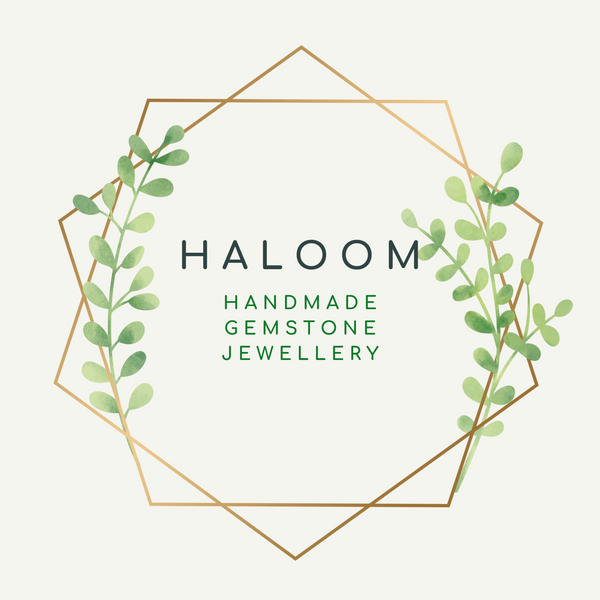A guide to gemstone grades and quality
Gemstones have long been admired for their beauty, rarity, and special energies. If you are looking to understand gemstone quality better, this guide will give you clear information about gemstone grading, how different grades affect appearance and value, and the grades of gemstones used at Haloom Handmade Jewellery.

Do gemstones have different grades?
Yes, gemstones come in different grades that reflect their quality, appearance, and value.
Grading helps you understand differences between stones by focusing on clarity, colour, cut, and size.
Unlike diamonds, coloured gemstones like amethyst, garnet, and citrine do not have a fully standardised global grading system. However, many jewellers, including Haloom, follow common grading terms to describe the quality of gemstones clearly and honestly.
What affects gemstone quality?
Several important factors influence the grade of a gemstone:
- Clarity: how clear the gemstone is and how visible the natural inclusions are
- Colour: how rich, vibrant, and even the colour appears
- Cut: how well the stone has been shaped and polished, affecting its shine
- Size: larger stones are rarer and often more valuable if the quality is good
- Treatment: whether the gemstone is untreated, treated, or synthetic also impacts its value
Each type of gemstone has its own natural qualities. For example, a good-quality rose quartz will naturally look more cloudy than a good-quality citrine.
Common gemstone grades explained
Gemstones are usually grouped into letter grades. Here’s what they mean:
AAA or A+ grade — exceptional quality
- excellent clarity with little to no visible inclusions
- rich, vibrant, and even colour
- highly polished with strong luster
- rare and priced higher because of scarcity and beauty
AA or A grade — very good quality
- mostly clear stones with small, less noticeable inclusions
- attractive and lively colour, though slightly less vivid than AAA stones
- a great balance between beauty and value, often used in fine jewellery
A/B or B grade — good quality with good value
- some visible inclusions or colour irregularities
- colour might be slightly uneven or lighter
- visually appealing and affordable, good for everyday jewellery
B/C or C grade — natural, rustic beauty
- obvious inclusions and uneven colour
- colour may appear duller or less consistent
- ideal if you appreciate a raw, earthy look
How do gemstone grades affect prices?
Gemstone prices depend heavily on their grade.
Higher-grade gemstones like AAA and AA are rarer, more visually striking, and naturally more expensive.
Lower-grade gemstones like B and C are more affordable but still valued for their unique natural beauty.
Pricing is also influenced by:
- type of gemstone
- size of the gemstone
- colour richness and evenness
- presence or absence of treatments
- market demand and trends
Sometimes, a well-cut, lively AA-grade gemstone can be more appealing than a dull AAA-grade stone. Grading is important, but beauty is also personal.

What gemstone grades are used at Haloom Handmade Jewellery?
At Haloom Handmade Jewellery, most gemstones used are AA to A/B grade.
This means:
- the stones are genuine and natural
- they have beautiful colour and good clarity
- minor inclusions may be present, adding character without taking away from their beauty
Some designs may feature slightly higher or slightly lower grade stones, depending on the look intended.
By offering a variety of grades, Haloom makes it possible for you to find jewellery that suits both your style and your budget.
You can feel confident knowing that every gemstone is real and selected with care, offering both beauty and positive energy.
FAQ: Gemstone grades at a glance
What does AAA, AA, A, and B grade mean for gemstones?
These grades describe the quality of a gemstone based on clarity, colour, cut, and overall appearance. AAA is the highest grade, with excellent clarity and rich colour. B and C grades have more visible inclusions and less vibrant colour.
Is AA-grade gemstone good quality?
Yes, AA-grade gemstones are very good quality. They are mostly clear with only minor inclusions and have strong, attractive colour. They offer a great balance between appearance and price.
Can gemstones with inclusions still be beautiful?
Definitely. Inclusions are part of a gemstone’s natural formation. Many people find inclusions charming because they make each stone unique. Some stones, like rutilated quartz, are valued because of their inclusions.
Are all Haloom jewellery pieces made with the same grade of gemstones?
Most Haloom pieces use AA to A/B grade gemstones, but some designs may feature higher or lower grade stones. This gives you different options for different styles and budgets.
Does gemstone grade affect the energy of the stone?
The grade mainly affects how the stone looks. Many believe the energy of a genuine gemstone stays strong whether the stone is high-grade or has inclusions. What matters most is that the gemstone is natural and untreated, which Haloom is committed to offering.
